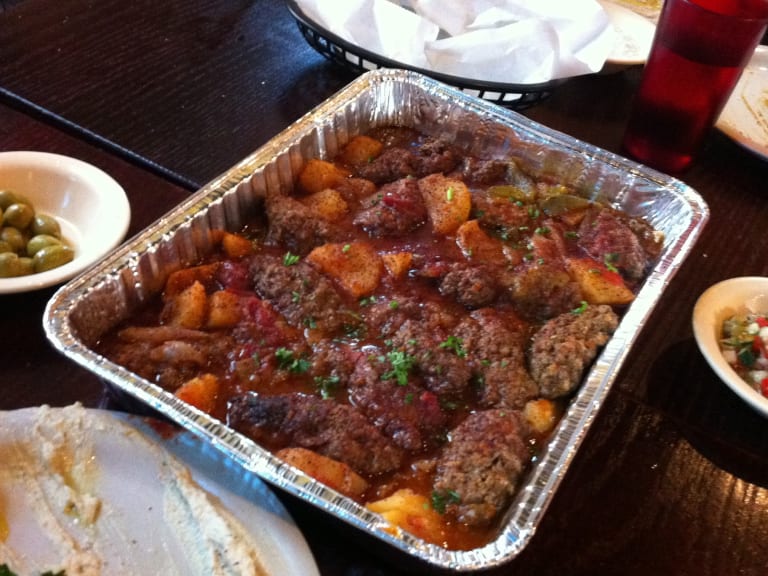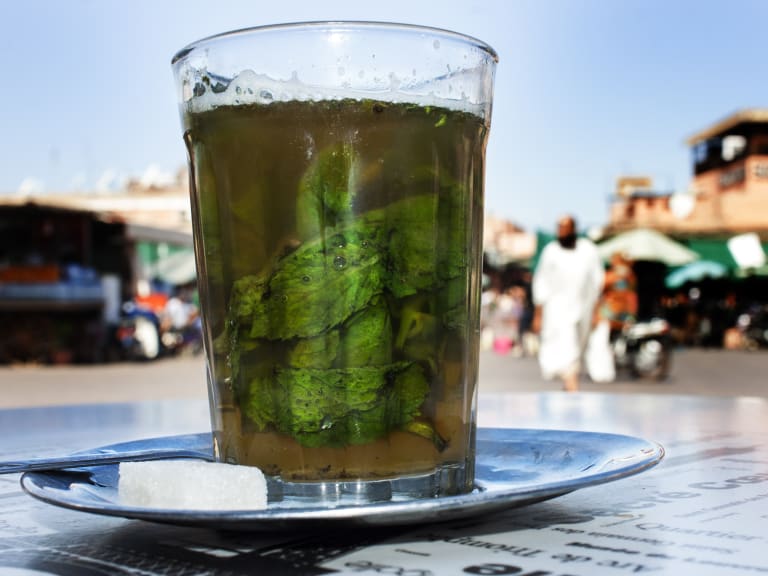Moroccan food: the dishes you can't miss
The typical food of Morocco is, despite the proximity, quite unknown. However, it is composed of a large number of dishes that will not leave anyone indifferent.

©Henry Dick
Moroccan food is made up of a number of dishes that no traveler should miss. In fact, tasting these dishes is a fundamental part of visiting this city, and the best way to do it is by booking a gastronomic tour of Marrakech by Marrakech. You won't regret it!
One of the best experiences in any trip is to discover the gastronomy, since its flavors, smells, condiments and ways of preparation are an important part of the culture. In Morocco, its culinary offer ranges from tajines to couscous, through the harira or tangia and is characterized by the presence of spices that significantly enhance its flavor.
Tajine

In fact, this dish is named after the container in which it is cooked, as is the case with Spanish paella, which is an earthenware pot with a lid in the shape of an elongated cone.
Various types of vegetables are cooked in the pot along with the chosen meat (lamb, beef or chicken) and various different spices are added, such as turmeric and cumin. The cooking in its most traditional form must be slow, to the point that the dish takes several hours to be finished. In addition, the peculiar shape of the container means that the steam remains inside and the meat is more tender and flavorful.
Although they are all known as tajine, there are actually several types depending on the ingredients added. Some of the best known are chicken with lemon, beef with plums and, on more special occasions, lamb. We recommend you to book a complete gastronomic tour to get to know all the variations, since there is also the Berber tajine, typical of the desert, and in the coastal areas you may also find some fish and vegetable tajines.
Koftas

This dish is one of the most widespread in much of the world. You will find it with different names depending on the country: köfte, kafta, kufta, kufteh... and it is simply minced meat mixed with spices and some other ingredients.
Very popular from Morocco to Pakistan, passing through India, Turkey, the Balkans, the Middle East and Central Asia, the main protagonist of this dish is the meat, generally beef or lamb. If you have been to Marrakech with children, this recipe is likely to become one of their favorites.
To make koftas, all you need to do is chop the meat and then add garlic, parsley and onion. As for the spices, their number and type depends a lot on each cook. In Marrakech it is quite common to add Ras el Hanout, although it can also contain paprika, ginger or coriander. It can be presented in the form of a kind of meatball to something similar to a small hamburger. In the street stalls of the medina of Marrakech and, in general in Morocco, it is also often found inserted in a wooden stick as if it were a skewer.
Harira soup

It is not necessary to travel to Marrakech in winter (or any other city in the country) to enjoy a good soup. As in the rest of the Arab countries, this dish is very popular throughout the year and there is even a version that is eaten for breakfast.
The best known of them all is the harira, a soup with a high nutritional value. For this reason, it is traditional to take it when breaking the fast during the days of Ramadan, but you can find it at any time in the country's restaurants.
According to some hypotheses, the origin of the recipe was in Al-Andalus and then it became popular in much of North Africa. Harira soup includes vegetables, cereals, meat and legumes, usually chickpeas. However, what gives it its delicious flavor are the aromatic herbs (such as coriander or mint), tomato, lemon and, of course, spices such as harissa, which gives it a spicy touch. All this is thickened with a little flour.
Couscous

If you travel anywhere in Morocco there is one food you can never miss: couscous. The name of the dish comes from the main ingredient, the aforementioned couscous, which is nothing more than wheat semolina.
As they will explain if you hire a gastronomic tour in Marrakech, for which you can buy your tickets now, there are almost as many ways to prepare this dish as there are houses. It all depends on the ingredients used to make the stew that accompanies the semolina. In all cases a large quantity of vegetables is used, accompanied by **meat, chickpeas, onions, raisins and sometimes plums, although in the south of the country these sweet touches are less present.
To cook the semolina in the traditional way you have to use a cuscusera, a kind of steamer with a strainer over the casserole. Thus, in the lower zone the ingredients of the stew are cooked and in the upper zone the couscous itself is cooked. Although this system offers the best results, the cooking process of the semolina can take hours.
Méchoui

The word méchoui, meshoui or meshwi means "roast" in Arabic, so it is not difficult to guess what this popular Moroccan dish consists of. The main ingredient is lamb, the meat of which is the most prized throughout North Africa and the Middle East. Originally, the animal was roasted in a hole d ug in the ground and previously filled with wood. When these became embers, the whole lamb was put in and buried. The cooking lasted several hours.
Obviously, the version found today in the best restaurants in Marrakech uses more modern methods. The ember is still the ideal way, but in some places it is also roasted in an oven. For added flavor, the meat is usually basted with a not-too-spicy version of harissa sauce.
If you are going to be in Marrakech for more than two days, I recommend you look for this dish to try.
Pastilla or pastilla

One of the most popular street foods in Morocco (although it is also served in some restaurants) is the pastilla or pastilla.
Possibly, if you have been around the medina of Marrakech, alone or with a gastronomic tour, for which you can book your tickets here if youhaven't done it yet, you will have seen quite a few stores selling it, as it is very popular among both locals and visitors. I recommend, however, that you follow the safety advice in Marrakech and only buy it in places you trust.
It's a kind of phyllo or puff pas try filled with shredded poultry meat, raisins and dried fruits such as pistachios or walnuts. Although most of the ones you will find are chicken, traditionally it was prepared as pigeon meat and nowadays those prepared with pigeon are considered an almost luxury food because of its flavor. It is decorated with cinnamon and powdered sugar, and that mix between sweet and salty flavor that makes this dish unique and delicious.
Tangia

Tangia is possibly the least known of Morocco's traditional dishes, so if you visit the country you should not miss it. The dish is a meat stew. The recipe includes lamb, garlic, cumin, turmeric and preserved lemons that are typical of the country. All this is cooked in a tangia, a jar that gives its name to the recipe.
Apart from the spectacular taste of the dish, the history behind it is also interesting. Thus, it was the men who took the jar to the oven in their neighborhood in the mornings when they left for work. The container was buried under the ground, between the embers of the fire for about 5 hours. When the workers finished their work, they would pick it up to enjoy its flavor.
Whether you have taken a guided tour or if you have already learned to move around Marrakech and want to try tangia, I advise you to go to the medina to find one of the places that serve it. One of them, the Souk Café offers a particularly delicious one.
Mint Tea

No one who has been in Morocco, no matter how long they have stayed in the country, has left without tasting this delicious drink.
Mint tea, which actually contains mint, can be considered the national drink. Not only will you find it in restaurants, tea shops and cafes, but it is often offered in any store where you spend more than 15 minutes.
Although the recipe is very simple, water, tea, mint and a good amount of sugar, it is difficult to find one as good outside Morocco or tea shops run by people from the Maghreb.
The drink is served in narrow, low cups, always hot, regardless of whether you have traveled in the summer to Marrakech. Its omnipresence is not only due to its taste, but it is considered a symbol of hospitality that should be offered to any visitor. According to the Moroccan saying, tea has to be served three times: the first glass is "bitter as life; the second "strong as love"; and the third "sweet as death".
To taste it, there is no better place than the terraces overlooking the Jamaa el Fna in Marrakech or in a cafe located in the port of Essaouira, with beautiful views of the Atlantic.
Sweets

Moroccan pastries are quite different from those found in Europe, as their main ingredients are honey, dates, dried fruits, semolina and dried fruits.
Anywhere in Morocco you will find a large number of stores selling these sweets. In addition, you can also try them in cafes or pastisseries, a name that comes from the country's French heritage.
Among the best known are the famous baklavas, the curious gazelle horns or makrud, but the variety is such that you will be unable to try them all.
Spices

Although they are not a food in themselves, no one can doubt the importance of spices in the Moroccan gastronomy. Without them, all the dishes you will taste during your travels would be really different.
In addition, spices are also part of the tourist attractions that you will find in the country. In each city there is a part of the souk specifically dedicated to their sale. Few experiences are more typical of the country than strolling through Rahba Kedima square in Marrakech immersed in the color and smell of spices.
The number of spices that you will find is almost endless, but here I leave you the name of the most used in case you dare to experiment with them on your return:
- Ras el Hanout: the star of Moroccan food. Actually, it is a mixture of spices with no fixed recipe, as each store boasts of making the best one. It is said that up to 30 different spices are used to create this mixture.
- Cumin: if you are used to the canned cumin sold in supermarkets, the smell and taste of this spice in Morocco will surprise you with its intensity.
- Harissa: another of the most used spices in Morocco. It is made with a concentrate of smoked and roasted red peppers to which caraway, salt and garlic are added. Be careful because in some cases it can be somewhat spicy, although less so than the spice used in Tunisia.
- Sesame: toasted on the grill to give a different touch of flavor to the dishes.
- Orange blossom water: it is obtained from the cooking of orange blossoms and its use is intended for Moroccan sweets and desserts.
- Lemons preserved in salt: used in many Moroccan stews, such as tangia.
